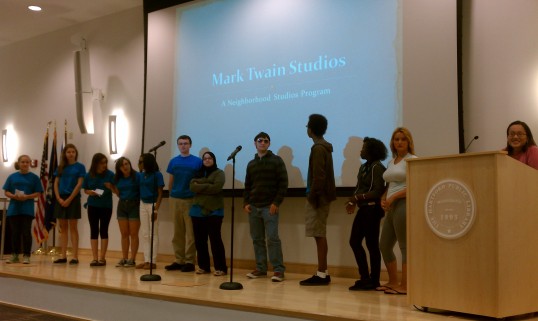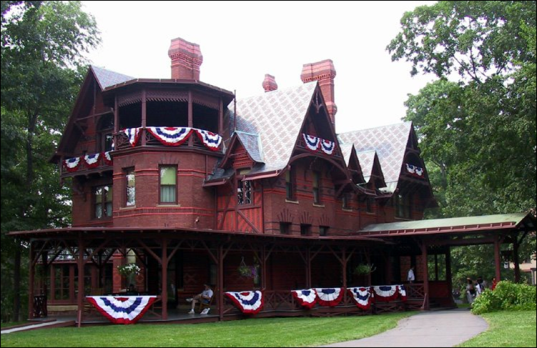By Alan Burkholder
Writing Apprentice
Twain Studios
Almost everyone in the world loves Mark Twain. There’s no denying that his work has had quite an impact on society, both in the past and in the present.
Don’t lie to me. You’ve heard the name Tom Sawyer before. If you know who Tom Sawyer is, you probably also know about his friend Huckleberry Finn. These two troublemaking brats have become two of the most famous child characters in all of literature. I say two of the most because a certain young woman from England has recently had more success in the way of children’s literature.
However, Samuel Clemens, who wrote under the name Mark Twain, is arguably the most celebrated author in classic American literature.
Being from a small town in Missouri, Twain had an American upbringing, and as such Twain’s books are very American in nature. These stories range from a story about a notorious gambler in Nevada who gets too cocksure about a jumping frog, to a man from Connecticut who winds up face to face with King Arthur and builds an industrial empire which later ruins their society. Whoops.
His books varied in message and tone, but Twain always had one quality which set him apart from other writers of the time: a sharp and dry wit. Twain was at heart a humorist, and he never stopped trying to be the witty gentleman, even in old age. He was aware of his humanity, and often poked fun at his own flaws.
“We ought never to do wrong when people are looking,” he wrote in “A Double-Barrelled Detective Story.”
But where did Clemens get his inspiration? What was the source of Twain’s persona as a witty individual?
Part of the blame can be pinned on Sam’s mother. While his father was strict and humorless, his mother was always the unconventional woman. She was humorous in nature and she bounced around from religion to religion, even once taking her son to a temple rather than a church.
According to Steve Courtney, publications editor at The Mark Twain House & Museum in Hartford, Connecticut, Sam and his mother would often joke a lot with each other, probably trying to see if they could outwit one another.
“This disposition to experiment is an inheritance from my mother,” Twain said in a Feb. 28, 1901 lecture reported in the New York Times.
Twain was also inspired by a lot of other people in his life. He based several characters in The Adventures of Tom Sawyer on his boyhood memories in Hannibal, Missouri. His mother became Aunt Polly, his childhood sweetheart became Becky Thatcher, and several troublemaking boys combined to make the ever-bothersome Huckleberry Finn. He also based the runaway slave Jim on his butler, George Griffin.
Twain wasn’t just about characters, though. He was also heavy into politics and could never keep his mouth shut about anything. The grand result of this love of satire was a book called The Gilded Age, in which Twain practically tore American values of the time apart at the seams and revealed the ugly truth beneath all of it, all the while never letting up or apologizing for his actions.
Despite his controversial nature, however, Twain was not a troublemaker. He was simply a rabble-rouser, and he always had a good reason for writing every shocking sentence he ever put to paper.
“Always do right,” Twain wrote in 1901. “This will gratify some people and astonish the rest.”
Twain’s work, to this day, continues to both gratify and astonish readers all over the world. Part of the reason is the way Twain presents his humor.
Mark Twain House & Museum Chief Curator Patti Philippon said Twain tended to write how people actually sound.
Instead of being flowery and poetic, Twain wrote his books in plain English so that the message wouldn’t be lost.
“You can understand (Twain) a lot better” than most writers of the time, Courtney said.
People had written plainly before Twain, Courtney said, but he was “the first to make it a point.”
Twain, however was never completely blunt. He realized that in order for the audience to get the message, he had to make it interesting. He didn’t tell you to be honest. He simply said, “when in doubt, tell the truth.”
Twain is not the only person in the world to use humor as a selling point, however. Modern entertainers borrow heavily from Twain’s method of telling stories like they happened. Good humor is always a welcome addition to any story.
Most modern comedies realize that in order to be funny, there doesn’t need to be a lot happening.
Shows like The Daily Show with Jon Stewart, The Colbert Report, and Louis CK’s Louie draw a lot of praise and laughs basically having a small group of people who have a small focus, but a lot of insight. I like to refer to this kind of humor as “Seinfeldian,” after the show (and comedian) that made it popular.
One person who’s familiar with this style of humor is Patrick Skahill, the producer of WNPR’s The Colin McEnroe Show, a Connecticut-based radio program that deal heavily with satire and wit.
Before each show, Skahill said, the producers and stars of the shows “keep an eye out for weird stories,” and then “brainstorm and think of ideas” that they want to discuss.
“Most of it is on the fly,” Skahill said.
Humorists don’t always script everything. Often, they just come up with ideas and work with them from there. This was certainly true of Huckleberry Finn, which started out as the sequel to a boy’s book and turned into one of the most humorous and heartfelt books in recent history. A lot of modern humor is based on social satire. Twain was not shy about social satire.
Twain did a lot of lecturing in his time, which was basically the 19th century equivalent of stand-up comedy. He would go out on stage, start telling a tale, and leave the audience roaring.
Off the stage, Clemens was shy and hated talking to people. On stage, he was a social commentator who seemingly knew more about the country than every politician of the era combined.
Philippon said Twain and Clemens were the same at the core, but Twain was more of a “persona.”
Twain used this persona when writing jokes, because Twain was much funnier. The same can be said for a lot of modern comedians. Everyone adopts a sort of stage persona, whether it be the loudmouth who loves to judge people, the quirky girl who observes a lot of crazy stuff happening, or the good-natured fat guy who likes to poke fun at himself.
All have a character on the stage who represents an exaggerated version of themselves. They earn bonus points if they act like this off of the stage as well.
Comedy writers also like to indulge in exaggeration for comic effect. Twain was a master in this field, especially when it came to his satire. Early in his career, Twain wrote in a newspaper about a “Terrible accident” that hadn’t actually happened, a satire on the sometimes alarmist nature of the news. Alarmingly enough, this kind of satire still holds up today, as several members of Saturday Night Live could easily attest.
Twain’s humor is timeless, touching on topics that are still relevant after about 150 years. To this day, people still follow his lead, in comedy, drama and in writing overall.
In his story, “Green Hills of Africa,” novelist Ernest Hemingway wrote, “All of modern American literature can be traced back to … Mark Twain’s Adventures of Huckleberry Finn.”
It seems rather ridiculous to place this much credit upon one person, but Twain was brilliant enough to deserve it at the time.
And he still deserves it today.
Posted in
Uncategorized and tagged
Alan Burkholder,
arts,
Clemens,
Daily Show,
Double-Barrelled Detective Story,
Greater Hartford Arts Council,
Huckleberry Finn,
Mark Twain,
Tom Sawyer,
Twain,
Twain Studios,
Write to the Point!,
Writing |
 Write to the Point! at The Mark Twain House & Museum, the newest member of the wonderful Neighborhood Studios program of the Greater Hartford Arts Council. The terrific work these teen writers did at Twain Studios this summer wouldn’t have been possible without the help of a lot of people who truly care.
Write to the Point! at The Mark Twain House & Museum, the newest member of the wonderful Neighborhood Studios program of the Greater Hartford Arts Council. The terrific work these teen writers did at Twain Studios this summer wouldn’t have been possible without the help of a lot of people who truly care.



















